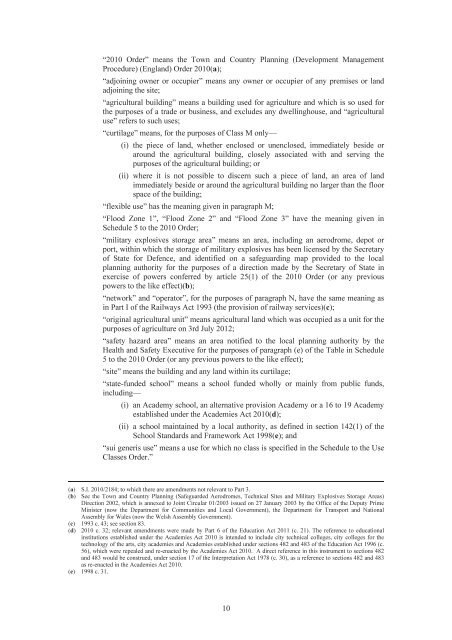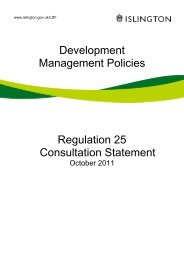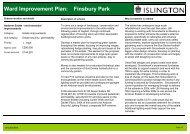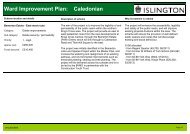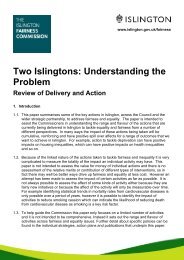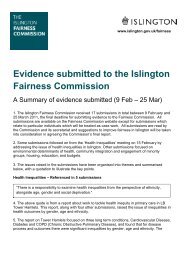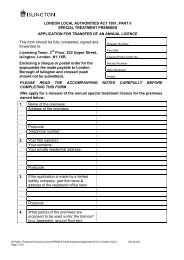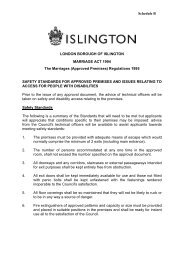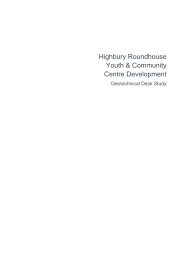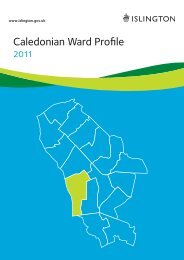2013 No. 1101 TOWN AND COUNTRY ... - Legislation.gov.uk
2013 No. 1101 TOWN AND COUNTRY ... - Legislation.gov.uk
2013 No. 1101 TOWN AND COUNTRY ... - Legislation.gov.uk
You also want an ePaper? Increase the reach of your titles
YUMPU automatically turns print PDFs into web optimized ePapers that Google loves.
“2010 Order” means the Town and Country Planning (Development Management<br />
Procedure) (England) Order 2010(a);<br />
“adjoining owner or occupier” means any owner or occupier of any premises or land<br />
adjoining the site;<br />
“agricultural building” means a building used for agriculture and which is so used for<br />
the purposes of a trade or business, and excludes any dwellinghouse, and “agricultural<br />
use” refers to such uses;<br />
“curtilage” means, for the purposes of Class M only—<br />
(i) the piece of land, whether enclosed or unenclosed, immediately beside or<br />
around the agricultural building, closely associated with and serving the<br />
purposes of the agricultural building; or<br />
(ii) where it is not possible to discern such a piece of land, an area of land<br />
immediately beside or around the agricultural building no larger than the floor<br />
space of the building;<br />
“flexible use” has the meaning given in paragraph M;<br />
“Flood Zone 1”, “Flood Zone 2” and “Flood Zone 3” have the meaning given in<br />
Schedule 5 to the 2010 Order;<br />
“military explosives storage area” means an area, including an aerodrome, depot or<br />
port, within which the storage of military explosives has been licensed by the Secretary<br />
of State for Defence, and identified on a safeguarding map provided to the local<br />
planning authority for the purposes of a direction made by the Secretary of State in<br />
exercise of powers conferred by article 25(1) of the 2010 Order (or any previous<br />
powers to the like effect)(b);<br />
“network” and “operator”, for the purposes of paragraph N, have the same meaning as<br />
in Part I of the Railways Act 1993 (the provision of railway services)(c);<br />
“original agricultural unit” means agricultural land which was occupied as a unit for the<br />
purposes of agriculture on 3rd July 2012;<br />
“safety hazard area” means an area notified to the local planning authority by the<br />
Health and Safety Executive for the purposes of paragraph (e) of the Table in Schedule<br />
5 to the 2010 Order (or any previous powers to the like effect);<br />
“site” means the building and any land within its curtilage;<br />
“state-funded school” means a school funded wholly or mainly from public funds,<br />
including—<br />
(i) an Academy school, an alternative provision Academy or a 16 to 19 Academy<br />
established under the Academies Act 2010(d);<br />
(ii) a school maintained by a local authority, as defined in section 142(1) of the<br />
School Standards and Framework Act 1998(e); and<br />
“sui generis use” means a use for which no class is specified in the Schedule to the Use<br />
Classes Order.”<br />
(a) S.I. 2010/2184; to which there are amendments not relevant to Part 3.<br />
(b) See the Town and Country Planning (Safeguarded Aerodromes, Technical Sites and Military Explosives Storage Areas)<br />
Direction 2002, which is annexed to Joint Circular 01/2003 issued on 27 January 2003 by the Office of the Deputy Prime<br />
Minister (now the Department for Communities and Local Government), the Department for Transport and National<br />
Assembly for Wales (now the Welsh Assembly Government).<br />
(c) 1993 c. 43; see section 83.<br />
(d) 2010 c. 32; relevant amendments were made by Part 6 of the Education Act 2011 (c. 21). The reference to educational<br />
institutions established under the Academies Act 2010 is intended to include city technical colleges, city colleges for the<br />
technology of the arts, city academies and Academies established under sections 482 and 483 of the Education Act 1996 (c.<br />
56), which were repealed and re-enacted by the Academies Act 2010. A direct reference in this instrument to sections 482<br />
and 483 would be construed, under section 17 of the Interpretation Act 1978 (c. 30), as a reference to sections 482 and 483<br />
as re-enacted in the Academies Act 2010.<br />
(e) 1998 c. 31.<br />
10


